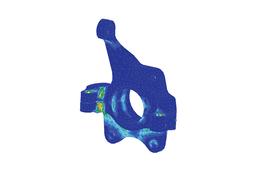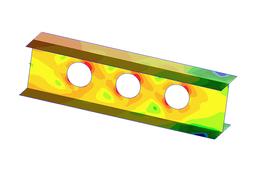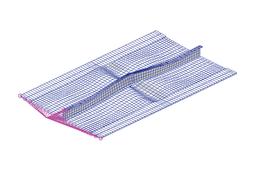
Multidiscipline Simulation Software Supplier, Linear and Nonlinear Finite Element Analysis (FEA), Control Systems Simulation and more
Analyze and improve acoustic performance of your products early in product development cycle to gain competitive advantage
We are surrounded by sounds, some pleasant, and quite a few that are not. In order for a product to be accepted by customers, manufacturers must pay close attention to its acoustic signature, both for branding purposes and to limit noise pollution. Engineers must also consider the noise regulations that govern their industry, prior to product release. Problems identified late in development cycle can lead to costly rework and a delayed product launch.
To improve the performance of the products, engineers need to understand the roles of noise sources and all the possible transmission paths. Because of the large domain of the model, it is critical to have efficient solvers and robust technology that can account for the interactions between structures and fluids. The finite and infinite element based technology from MSC Software is intuitive and easy to implement because of the familiar technology of FEA. It is also easier to couple with structural finite element analysis codes, helping you solve coupled interaction between structures and fluids.









MSC Software is used for many types of acoustic modeling:
- Standard and convected acoustics
- Analyzing interior or exterior vehicle acoustics
- Modeling transmission through flexible walls
- Predicting acoustic absorption by a porous medium
- 2D, Axisymmetric and 3D analysis
- Dissipation mechanisms such as viscothermal losses and acoustic absorption
- Acoustic propagation and radiation on top of a non-uniform mean flow
- Simulation of complex multilayered structures with composites material models
- Direct response and modal superposition approaches
- Modeling active structures with piezoelectric materials
- Heterogeneities such as complex flows and temperature gradients
- Basic Harmonic analysis
- Plane, spherical and cylindrical wave sources and excitation of ducts by incident plane waves
- Discontinuous Galerkin Method
- Transient CFD followed by acoustic radiation
- Visco-thermal elements for modeling thin air layers or thin tubes
- Modeling of liners accurately including the flow effects (Myers-Eversman formulation)
- Excitation defined by incident acoustic duct modes
Industry Uses:
- Aerospace: Sound transmission through cockpit and fuselage, engine nacelle liners, fuselage and cockpit insulation, ECS (environmental control systems), APU and ECS inlet and outlet silencers, trailing edges, sonars, helicopter turbine noise, random dynamic response of rocket payload at take-off, sonars.
- Automotive: Powertrain, trim design, wind noise, engine components, compressors, intake manifold, air filter, valve cover, baffling, electrical motors, loudspeakers, mufflers, tire noise, silencers, high pressure distribution ducts.
- Consumer Goods: Telephones, hands-free telecommunication, headsets, loudspeakers, hearing aids, musical instruments, washing machines, refrigerators, vacuum cleaners.
- Electronics: Disk drives, cell phones, cameras, LCD projector fans.
- Machinery: Turbomachinery, HVAC, lawn mowers and agricultural machines, exhaust systems.
Acoustic Radiation
 Analyze the radiation of sound in a fluid or in enclosed cavities to identify critical issues before prototype development.
Analyze the radiation of sound in a fluid or in enclosed cavities to identify critical issues before prototype development.
With the extensive acoustic analysis capabilities, you can extract acoustic modes, analyze sound radiation, model absorbing walls, study sound propagation in ducts, intake and exhaust lines, or distribution systems in building, aircrafts and automobiles.
Vibro-acoustics

In order to study the interaction of structural vibration with the adjacent fluid, it is necessary to model the behavior of the involved structural components and the fluid as well. With MSC, you can analyze interior acoustic problems like cabin noise and exterior acoustic problems to analyze noise radiation to the environment. You can incorporate complex, realistic boundary conditions along with appropriate structural material properties of trim components for damping behavior.
Aero-acoustics
 Aero-acoustics, is concerned with noise generated due to noise sources like turbulent flow within a fluid and its propagation within the fluid. The aerodynamic noise sources from flow simulations performed with commonly used CFD codes are recovered, and used to compute the aero-acoustic noise. You can also combine this capability with vibro-acoustics giving you the ability to model complex aero-vibro-acoustic problems.
Aero-acoustics, is concerned with noise generated due to noise sources like turbulent flow within a fluid and its propagation within the fluid. The aerodynamic noise sources from flow simulations performed with commonly used CFD codes are recovered, and used to compute the aero-acoustic noise. You can also combine this capability with vibro-acoustics giving you the ability to model complex aero-vibro-acoustic problems.
Related Products:
- Actran AcousticsPowerful Acoustic Simulation Software
- MSC NastranMultidisciplinary Structural Analysis
- SC/TetraThermo-fluid analysis with unstructured mesh
- scFLOWThermo-fluid analysis with polyhedral mesh


































